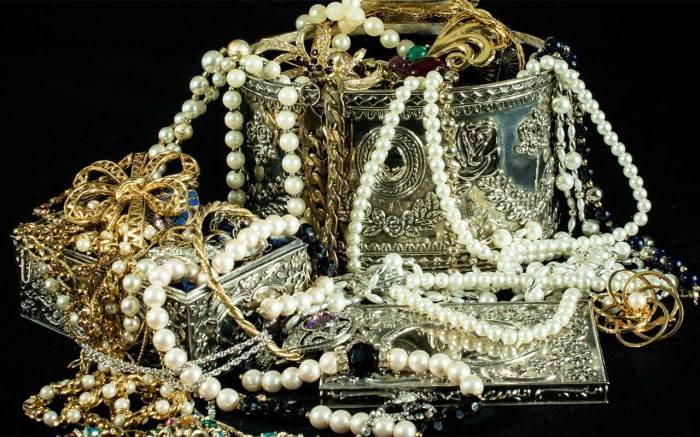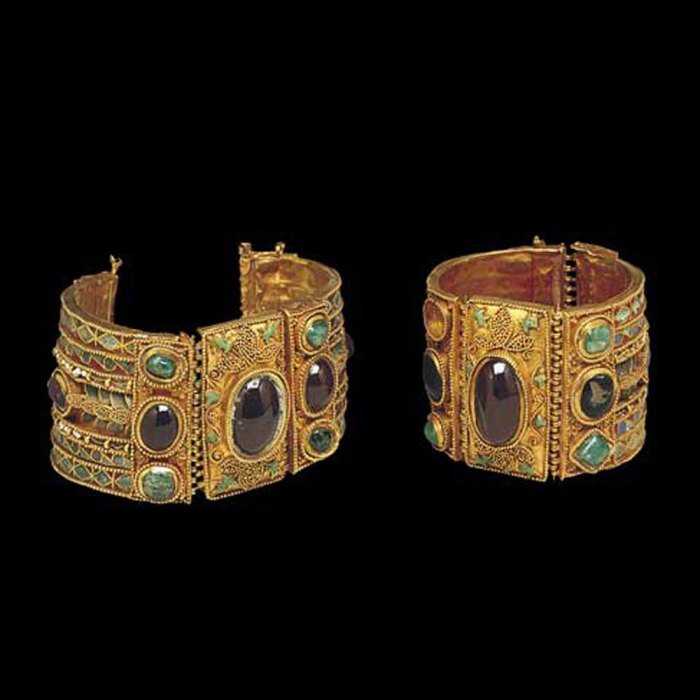The history and cultural significance of specific jewelry pieces sets the stage for this enthralling narrative, offering readers a glimpse into a story that is rich in detail with kompas author style and brimming with originality from the outset.
Jewelry has always played a significant role in human history, reflecting not just personal adornment but also cultural beliefs, traditions, and artistic expressions. As we delve into the evolution of these exquisite pieces, a tapestry of stories unfolds, revealing the intricate connection between jewelry and the societies that created them.
History of Jewelry Pieces
From ancient times to modern-day fashion, jewelry pieces have held significant cultural and historical value. These pieces have evolved over different eras, reflecting the artistic trends and societal norms of the time. Let’s delve deeper into the history of specific jewelry pieces and their cultural significance.
Evolution of Rings
Rings have been a symbol of love, commitment, and status throughout history. In ancient Egypt, rings were worn as symbols of eternity, with intricate designs and gemstones. The Romans used rings to signify social status, with gold bands worn by the elite. In the Middle Ages, rings were adorned with religious symbols and inscriptions, serving as both decorative pieces and expressions of faith.
Cultural Influences on Necklace Design
Necklaces have been an integral part of various cultures, each infusing its unique design elements. In ancient Mesopotamia, necklaces were crafted using beads and metals, symbolizing wealth and power. In Chinese culture, jade necklaces were believed to bring good luck and protection. The Victorian era saw a resurgence of intricate pearl necklaces, symbolizing purity and femininity.
Historical Figures and Events in Bracelet Popularity
Bracelets have been favored by historical figures and associated with significant events. Queen Victoria popularized charm bracelets in the 19th century, sparking a trend among the aristocracy. In the 1960s, the peace symbol became a common motif on bracelets, reflecting the counterculture movement. Today, bracelets are worn as fashion statements, with a variety of styles catering to different tastes.
Cultural Significance

In various cultures around the world, specific jewelry pieces hold deep symbolic meanings and play significant roles in rituals, ceremonies, and traditions. These pieces are often more than just accessories; they are imbued with cultural history and spiritual significance.
Symbolic Meanings
In many cultures, jewelry pieces such as rings, necklaces, and bracelets are used to symbolize various aspects of life. For example, a wedding ring symbolizes unity and eternal love in Western cultures, while in some Eastern cultures, jade bracelets are worn to attract good luck and protect the wearer from negative energies. These symbolic meanings vary widely across different societies but often reflect common themes such as love, protection, and prosperity.
Use in Rituals and Ceremonies
Specific jewelry pieces are often an integral part of rituals and ceremonies in different cultures. For instance, in Hindu weddings, the bride wears intricate gold jewelry known as “Mangalsutra” to signify her marital status and commitment to her husband. Similarly, in many African cultures, beads are worn during coming-of-age ceremonies to mark the transition from childhood to adulthood. These rituals not only showcase the cultural significance of jewelry but also highlight the importance of tradition and heritage.
Stories and Myths
Many jewelry pieces have origin stories or myths associated with their cultural significance. For example, the Maori people of New Zealand have a tradition of wearing “Hei Matau” or fish hook necklaces, which are believed to bring prosperity and safe journeys at sea. According to Maori mythology, the demi-god Maui used a magical fish hook to pull up the North Island of New Zealand from the sea, giving rise to the symbolic meaning of the Hei Matau.
Remember to click Choosing the perfect jewelry style to flatter my face shape to understand more comprehensive aspects of the Choosing the perfect jewelry style to flatter my face shape topic.
These stories not only add to the allure of the jewelry pieces but also connect wearers to their cultural heritage and ancestral beliefs.
Browse the implementation of Ethical sourcing and conflict-free diamond jewelry buying guide in real-world situations to understand its applications.
Materials and Techniques: The History And Cultural Significance Of Specific Jewelry Pieces
Traditional jewelry pieces are crafted using a variety of materials and intricate techniques that have been passed down through generations. Let’s explore the traditional methods and compare them with modern techniques used in creating these timeless pieces.
Materials Used in Traditional Jewelry Making
Historically, jewelry pieces were crafted using materials such as:
- Gold: A precious metal that symbolizes wealth and luxury.
- Silver: Known for its lustrous shine and versatility in jewelry making.
- Gemstones: Including diamonds, rubies, emeralds, and sapphires, adding color and brilliance to the pieces.
- Pearls: Organic gems from oysters, treasured for their natural beauty.
Techniques Employed in Traditional Jewelry Making
Artisans would use intricate techniques such as:
- Handcrafting: Each piece was meticulously crafted by hand, showcasing the artisan’s skill and precision.
- Engraving: Adding intricate designs and patterns to metal surfaces for a decorative touch.
- Filigree: Creating delicate and ornate designs by twisting and curling fine metal wires.
- Setting Gemstones: Carefully placing gemstones into metal settings to secure them in place.
Comparison with Modern Techniques
In modern jewelry making, while traditional techniques are still revered, advancements have allowed for:
- Computer-Aided Design (CAD): Allowing artisans to create intricate designs digitally before production.
- 3D Printing: Utilizing technology to bring complex designs to life with precision and efficiency.
- New Materials: Incorporating materials like titanium and stainless steel for contemporary pieces.
- Mechanical Settings: Using machines for precise gemstone settings, ensuring durability and accuracy.
Influence on Fashion and Art
Throughout history, jewelry pieces have had a significant impact on fashion trends and artistic expressions. These adornments have inspired designers, artists, and creators in various art forms, influencing styles and aesthetics.
Fashion Trends
Jewelry pieces have played a crucial role in shaping fashion trends over the years. From ancient times to modern-day, these accessories have been used to complement, enhance, or even redefine clothing styles. Whether it’s a statement necklace, a pair of earrings, or a bracelet, jewelry has the power to elevate an outfit and make a fashion statement.
Artistic Inspirations
Artists and designers have drawn inspiration from jewelry pieces in their creative works. The intricate designs, craftsmanship, and symbolism found in jewelry have influenced various art forms, including painting, sculpture, and literature. Artists often incorporate elements of jewelry into their artworks to add depth, meaning, and beauty.
Representation in Art, The history and cultural significance of specific jewelry pieces
Jewelry pieces have been prominently featured in paintings, sculptures, and literature throughout history. They serve as symbols of status, wealth, love, and identity in artistic representations. From portraits showcasing luxurious gemstones to sculptures depicting intricate jewelry designs, these adornments have been immortalized in art, reflecting their cultural significance and aesthetic appeal.
Final Summary

As we conclude this exploration into the history and cultural significance of specific jewelry pieces, one thing becomes abundantly clear: these shimmering treasures are not just accessories, but embodiments of human creativity, heritage, and identity. With each piece carrying a unique tale, we are reminded of the enduring allure and timelessness of jewelry in shaping our past and present.
FAQ
How did specific jewelry pieces evolve over different eras?
The evolution of specific jewelry pieces was influenced by changing societal norms, technological advancements, and artistic movements, leading to diverse styles and designs over time.
What are some common symbolic meanings associated with specific jewelry pieces?
Specific jewelry pieces often symbolize love, power, protection, or status in different cultures, reflecting the values and beliefs of the society that created them.
How have specific jewelry pieces inspired fashion trends throughout history?
Specific jewelry pieces have been a constant source of inspiration for fashion designers, influencing trends and styles that resonate with the cultural heritage and historical significance of these pieces.